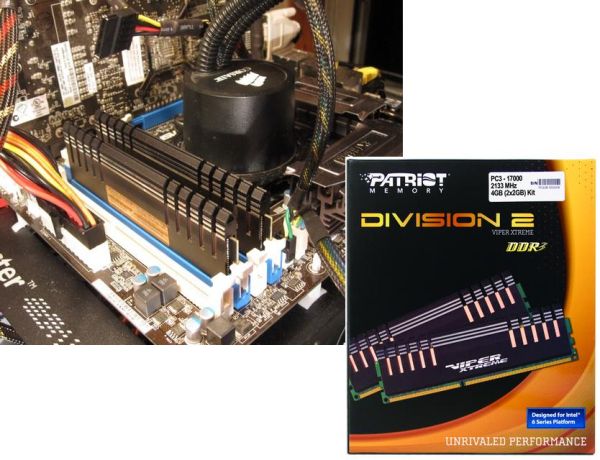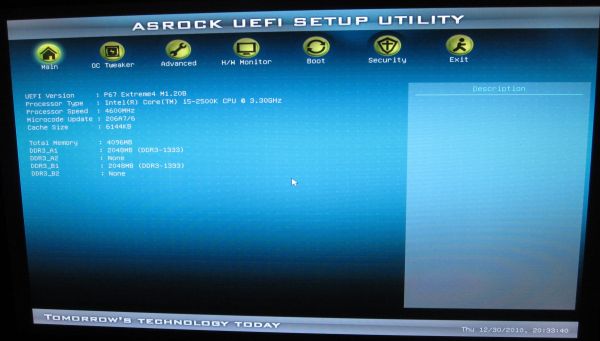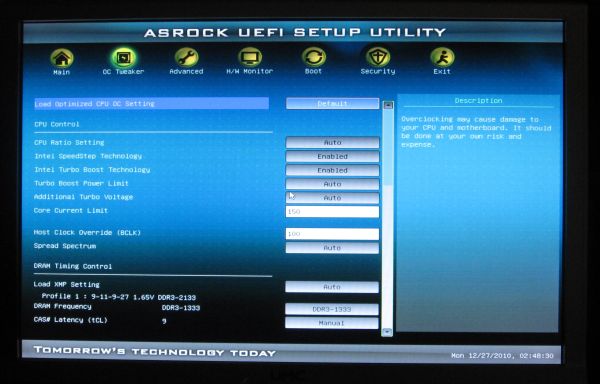Welcome to Sandy Bridge, with the ASRock P67 Extreme4
by Ian Cutress on January 3, 2011 7:00 AM EST- Posted in
- Motherboards
- ASRock
Test Setup
| Processor |
Intel i5-2500K ES—3.3GHz (3.7GHz Turbo) 4 Cores, 4 Threads, 6MB L3 |
| Motherboards | ASRock P67 Extreme4 |
| Cooling | Corsair H50-1 Water Cooler |
| Power Supply | Enermax Modu87+ 600W 80PLUS |
| Memory |
Patriot Viper Xtreme DDR3-2000 9-10-9-27 2x4GB Kit, 1.65V Patriot Viper Xtreme Division 2 DDR3-2133 9-11-9-27 2x2GB Kit, 1.65V |
| Memory Settings | Patriot Viper Xtreme Division 2 2x2GB @ DDR3-1333 9-9-9-27 |
| Video Cards | XFX HD 5850 1GB |
| Video Drivers | Catalyst 10.12 |
| Hard Drive | Intel X25-M 80GB SSD Gen2 |
| Optical Drives | LG GH22NS50 |
| Case | Open Test Bed—CoolerMaster Lab V1.0 |
| Operating System | Windows 7 64-bit |
| USB 2/3 Testing | Patriot 64GB SuperSonic USB 3.0 |
Each motherboard received a fresh operating system install before testing and benchmarking. For multi-GPU comparisons, dual XFX HD5850 GPUs at stock clocks were used with Catalyst 10.12 drivers. Memory is set at DDR3-1333 C9 to allow comparison to future H67/H61 motherboards.
Many thanks to Patriot Memory for sending their Viper Xtreme DDR3 kits to use in reviews. The 2x4GB kit, specifically for dual-channel operation, is rated at 2000MHz, CAS 9-10-9-27 at 1.65V and retails for $175. The 2x2GB Division 2 kit, also for dual-channel, is a newly released part by Patriot, specifically for P67, and runs at 2133MHz, CAS 9 11-9-27 at 1.65V. I am informed that this kit will retail for around $100.
Another comparison point for this review is an X58, socket 1366 system, based on the ASRock Extreme3 board that I reviewed in 2010. Quite a lot of people will have invested in an X58 system over the past twelve months, in the pursuit of performance, and it will be interesting to see how the stock i7-920 processor, and the P67 systems with the i5-2500K processor, compares.
| Test Setup | ||
| Processor |
Intel i7-920 d0—2.67GHz (2.93GHz Turbo) 4 Cores, 8 Threads, 8MB L3 |
|
| Motherboards | ASRock X58 Extreme3 | |
| Cooling | Akasa Nero | |
| Power Supply | Enermax Modu87+ 600W 80PLUS | |
| Memory | Corsair Vengeance DDR3-1600 9-9-9-24 3x4GB Kit, 1.50V | |
| Memory Settings | Corsair Vengeance DDR3-1333 9-9-9-24 3x4GB | |
| Video Cards | XFX HD 5850 1GB | |
| Video Drivers | Catalyst 10.12 | |
| Hard Drive | Samsung PB22-J SSD 60GB | |
| Optical Drives | LG GH22NS50 | |
| Case | Open Test Bed—CoolerMaster Lab V1.0 | |
| Operating System | Windows 7 64-bit | |
The results for other P67 motherboards are included also in this review to provide points for comparison. Full reviews for these boards will be published shortly. A note on the Gigabyte P67A-UD4 board - the latest BIOS at time of writing (F5) seems to have issues with its Turbo mode, resulting in a 1x multiplier increase rather than the expected 4x when one core is active. As such, results from the UD4 in single threaded benchmarks may be lower than expected. These results will be updated if the BIOS is fixed by the time that review is published. Update: The F7 Beta BIOS for the UD4 implements turbo correctly - the graphs have been updated.
UEFI
One of the main features of the Sandy Bridge platform is the new BIOS interface, the Unified Extensible Firmware Interface (UEFI). Almost everything about the UEFI is similar to the BIOS system of old—the menus and the options are identical. The only difference is the GUI—we now get colors and images (which I can see getting more elaborate as the system grows in time), and the use of the mouse. Each vendor's UEFI implementation will be visually quite different, if they've implemented it at all.
Initially, you will find that in the Extreme4 UEFI, the mouse wheel does not work. This is not a massive deal-breaker, by any means. I still prefer using the keyboard to navigate all the options, and I had no issues in using the arrow keys. You can’t use the number pad to put in voltages and such, which would be a nice touch.
The main menu option of choice is the optimized CPU OC setting. In general, it is best not to trust this option on any motherboard, but ASRock have done a good job here. It offers auto-overclocking settings from 4.0GHz to 4.8GHz in 0.2GHz steps, which as I’ll talk about below, the 4.6GHz setting is the preferential setting for our 24/7 overclock.
The CPU multiplier and BCLK are fully adjustable. The memory timings are linked for every memory stick in the board—as this isn’t the highest end board, we didn’t expect the ability to set every channel independently. The board also allows saving up to three profiles, and OC recovery worked when we overclocked to 5GHz while setting a low voltage.
One thing of note is that the ASRock UEFI version 1.20B sets the BLCK over the 100MHz standard. ASRock have set this at 100.4MHz (even though this isn’t visible in the UEFI, only in the OS), meaning that they hope to gain a 0.4MHz BCLK advantage over other manufacturers at stock speed. We experienced no instability due to this, so we will see how this affects the results against other motherboards.
As a first go, the ASRock UEFI interface isn't radically different, but it works well. We're more interested in seeing the UEFI system enhancements over the coming months! It opens up a lot of new options if anyone puts the necessary effort into it, so we could see some very cool additions down the road.



















55 Comments
View All Comments
zipzoomflyhigh - Tuesday, January 4, 2011 - link
1 yr warranty? REally?regginGUY - Wednesday, January 5, 2011 - link
Please explain why this motherboard did so much worse than the others. Something doesn't add up.IanCutress - Saturday, January 8, 2011 - link
That board didn't fair as badly as you claim. In the system benchmarks, it performs very well, and in the 3D benchmarks it's slightly worse than the ASRock in single card (as does the Gigabyte) but performs very admirably in dual card.Don't forget, each benchmark has a statistical variation on it, so the results could easily be +/- a certain amount, depending on the consistency of the benchmark. You'll never get the same score on 100 consecutive runs unless the benchmark is written so that the cache management is pre-optimised before every run (which a few synthetics do).
The 3D benchmarks are representative a typical game. For example, a lap on Dirt2 with a lot of action will have a lower framerate than one where you spend all the time out in front. The benchmark in Dirt2 does a bit of both, by starting the car at the back of the grid, performs some overtakes, and sometimes gets easily overtaken, representing an average lap.
Ian
IanCutress - Monday, January 10, 2011 - link
I've actually come across the problem now through my own testing. It turns out that Dirt 2 has an issue on how you do single card mode. If there is two GPUs in the system and you disable one in Catalyst, you get an FPS drop compared to running the benchmark with just one GPU in the system. This issue doesn't affect Metro 2033 in our benchmark suite, thus I'd have to conclude it's an issue with the Dirt 2 engine with AMD Catalyst.The new FPS figures for the ASUS and Gigabyte boards will be updated shortly. Full reviews of these boards will hopefully go up in the next couple of weeks.
Ian
oxyurus - Saturday, January 8, 2011 - link
Should have mentioned the x8/x8 pci 2.0 mode, as most of the boards at this price range are 16x/x4.Mephi5to - Sunday, January 9, 2011 - link
Take a look at the picture of the mobo - bottom left corner. PATA connector =/= IDE?Mephi5to - Sunday, January 9, 2011 - link
Nevermind :) I was so confused that actually went to their site and DL'd manual. It's a floppy connector. Sorry peeps.Shube - Monday, January 24, 2011 - link
The specs for this board show 32Gb max memory space using unbuffered DDR3. With 4 slots that means 8Gb memory sticks. I can't find any available. Does anyone have any idea when they will be available? At what speed? Any details appreciated!marraco - Sunday, January 30, 2011 - link
What about UEFI supposedly enhanced boot times?katleo123 - Tuesday, February 1, 2011 - link
good informative post about sandy bridgefor more info visit http://www.techreign.com/2010/12/intels-sandy-brid...